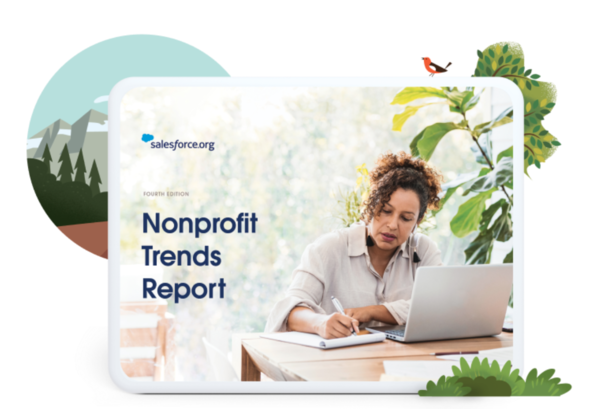Insights
INSIGHTS
All Topics
My Account
Charity trends from 2021 that will inform 2022
13 Jan 2022by Laura Stanley
We explore the key trends from the fourth edition of Salesforce.org’s Nonprofit Trends Report
The new year is a time for a fresh start. Charities have done a remarkable job keeping up with the constant chopping and changing around COVID-19, adapting to new situations and trends in everything from fundraising to service delivery.
Now, in 2022, it’s time to look back and take stock of which trends we can learn from and how we can carry those lessons into the future. This is where Salesforce.org’s Nonprofit Trends Report can help, outlining where we’ve been so we can map out where we’re going.
In the report, nonprofit employees from 10 countries shared their challenges and looked forward to the opportunities ahead. Issues that were of greatest concern to charities included adapting to remote and virtual programs, hosting in-person events, and implementing new technology to meet the increased demand for services.
Many of these challenges are direct consequences of the pandemic, which saw workers move home, much of service delivery move online – while other services could not be delivered at all – and fundraising become cashless and contactless.
But there were other, more long-standing challenges, such as improving the charity sector’s diversity and inclusion policies.
The trends report found that while nearly nine in 10 (87%) respondents agreed that it’s important to improve diversity and inclusion and 61% say their organisation has made commitments to do so, the perception and reality of progress made in these areas often clashed.
When asked where their organisation stands when it comes to diversity, equality, and inclusion (DEI), most respondents rated their diversity highly across all levels. Four in five said their organisation’s board of directors was diverse.
Fortunately, Salesforce.org found that overall, around half of nonprofits said their organisation had changed its approach to diversity and inclusion, and 85% said they met or exceeded their goals in this area. “While it might not be perfect, it is a step in the right direction,” according to the report.
The challenge of remote working
Charities also struggled with the shift towards remote and hybrid working, practices that have largely stuck around after COVID-19 restrictions necessitated them.
Remotely managing employees and volunteers was cited as a major issue for one-third of organisations over the last 12 months, and 84% of respondents predict it will remain difficult in 2022. A similar proportion (85%) said staff retention will also become a challenge.
This poses a problem for organisational growth, something many charities are increasingly concerned about given the rise in demand for their services. One-third (33%) of nonprofits changed their size in response to increased demand in the last year, while another third did so based on reduced demand.
Three in 10 respondents reported laying off or furloughing staff during the past 12 months. These organisations reported a workforce reduction of 30%, with COVID-related lockdowns in the U.S., U.K., and Australia likely to blame.
Overall, the report revealed that the sector has experienced a great deal of upheaval in the past two years, which is not particularly surprising in the wake of a global pandemic.
However, despite the challenges 2021 posed for the charity sector, there is hope for 2022. Respondents to the report said they achieved more than 75% of their goals across program delivery, fundraising, diversity initiatives, and staff wellbeing and retention.
If that’s not a good start, we don’t know what is.
Check out the report
Click above to access the full findings of Salesforce.org’s Nonprofits Trends Report
More on this topic
Related Content
Recommended Products
12 Mar 2025by Kalli Daffin
A guide to buying refurbished computers for your charitySponsored Article
07 Mar 2025by Laura Stanley
Marketing trends for charities in 2025
17 Feb 2025by Laura Stanley
Charity Digital Exchange: Grow your charity with AWS
Our Events
Charity Digital Academy
Our courses aim, in just three hours, to enhance soft skills and hard skills, boost your knowledge of finance and artificial intelligence, and supercharge your digital capabilities. Check out some of the incredible options by clicking here.

















